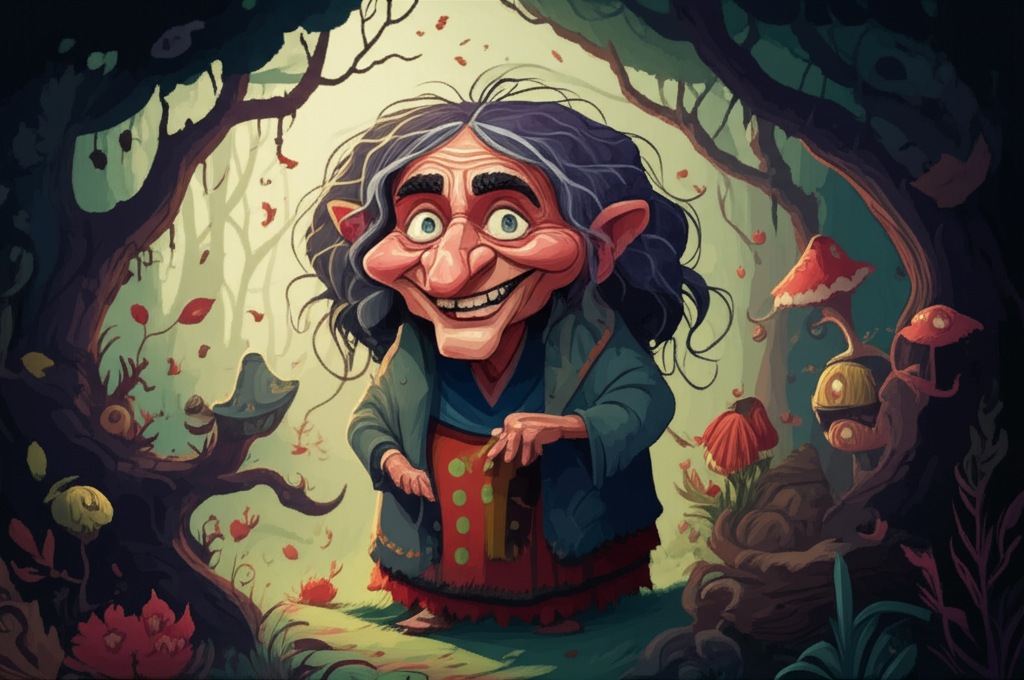
Important Note: This article explores a figure from traditional folklore for cultural, historical, and educational understanding. The stories and beings described are part of a mythological tradition and are not real. They are not meant to be believed, worshipped, or practiced.
Introduction
In the deep, ancient forests of Eastern Europe, where the canopy of birch and pine is so thick that daylight struggles to reach the mossy floor, old stories were once whispered around crackling fires. These tales were born from the land itself—a land of harsh winters, sprawling wilderness, and tight-knit communities huddled together against the vast unknown. From this rich soil of Slavic folklore grew one of its most enigmatic and enduring figures: Baba Yaga. She is not a simple witch or a straightforward villain, but a complex, primal force of nature, as unpredictable as the forest she calls home. This is a traditional story, an echo from a time when people sought to explain the world through powerful narratives.
Origins and Cultural Background
The legends of Baba Yaga predate written history, emerging from the oral traditions of the Slavic peoples who inhabited the regions of modern-day Russia, Ukraine, Poland, and their neighbors. In an era long before scientific explanation, the world was seen as a place alive with spirits and mysterious forces. People lived in an intimate, often fearful, relationship with nature. The forest was a place of duality: it provided wood for their homes, game for their tables, and herbs for their remedies, but it was also a place of immense danger. It was where one could get lost, where predators roamed, and where the known world ended and the supernatural began.
In this worldview, every element had a spirit. A domovoi guarded the home, a leshy protected the woods, and a rusalka haunted the rivers. Baba Yaga existed as the personification of the forest’s most dangerous and wild aspects. She was a way for ancient people to give a face to their anxieties about the wilderness, the trials of life, and the mysterious passage from childhood to adulthood. These stories were not just for entertainment; they were cautionary tales, morality lessons, and maps for navigating a challenging world.
Character Description: The Witch of the Woods
Baba Yaga is one of the most visually distinct figures in all of folklore. The stories describe her as a grotesque and fearsome crone. Her nose is said to be so long it touches the ceiling when she sleeps, her teeth are made of iron, and she often has one "bony leg," a symbolic attribute that connects her to the world of the dead or the serpent realm in some interpretations. She is ancient, wise, and utterly unpredictable.
Her dwelling is as famous as she is: a hut that stands on a pair of giant chicken legs. This bizarre home is not static; it can run through the forest, spin in place, and turn its back on unwelcome visitors. It is often described as having no windows or doors until a magical incantation is spoken. The hut itself symbolizes the wild, untamable nature of the world Baba Yaga inhabits—it is a threshold between the ordinary world and the realm of magic. Surrounding her hut is a fence made of human bones, topped with skulls whose eyes glow in the dark, a stark warning to all who approach.
Baba Yaga does not walk or run. Instead, she travels through the forest in a giant mortar, using a pestle as a rudder and sweeping away her tracks with a silver birch broom. These are tools of domesticity—for grinding grain and cleaning a home—twisted into instruments of supernatural power, representing her dominion over both the mundane and the magical. She is not purely evil; her role in the stories is that of a gatekeeper or a catalyst. She may help a hero who shows courage and respect, or she may devour a fool who approaches with arrogance or fear. Her actions are a reflection of the visitor’s own character.
Main Story: A Narrative Retelling
The tales of Baba Yaga often follow a similar pattern, usually involving a young protagonist sent on an impossible quest. One such story, echoing through many variations, speaks of a kind and gentle girl named Anya, whose cruel stepmother and stepsisters despise her. Seeking to be rid of her, the stepmother sends Anya deep into the forest to Baba Yaga’s hut, telling her to fetch a needle and thread.
Knowing the danger, but having no choice, Anya began her journey. The path grew dark and the familiar sounds of her village faded, replaced by the whispering of leaves and the snapping of unseen twigs. The forest seemed to watch her, its ancient trees leaning in like curious old men. After walking for what felt like an eternity, she came to a clearing. There, surrounded by a fence of glowing skulls, stood a hut perched on two enormous chicken legs.
Remembering the old words, Anya spoke with a clear voice, “Little hut, little hut, turn your back to the forest and your front to me.” With a great groan of timber and a squawk, the hut spun around to face her, revealing its door. Trembling, Anya stepped inside. There, in the dim light, sat Baba Yaga, her bony leg propped up, her iron teeth glinting.
“What do you want, child?” the old woman rasped, her voice like stones grinding together.
“My stepmother sent me to ask for a needle and thread,” Anya replied, her heart pounding.
Baba Yaga’s eyes narrowed. “Very well. You shall have it, but first, you must work for me. Weave this cloth, clean my hut, sort this pile of poppy seeds from this pile of dirt, and cook my supper. If you finish by the time I return, you may go. If not,” she added with a hungry smile, “I will cook you for my supper.”
With that, she flew off in her mortar, leaving Anya with a series of impossible tasks. Despair washed over the young girl. But Anya had always been kind. On her journey, she had given a crust of bread to a hungry mouse, and now the mouse and its family scurried out to help her, sorting the seeds with their tiny paws. Her respect for the home and her diligence allowed her to clean the hut to a shine. Her focus and skill, learned through hardship, let her weave the cloth perfectly.
When Baba Yaga returned, she was surprised to find all the tasks completed. She could find no fault. True to her word, though perhaps begrudgingly, she gave Anya a needle and thread. But she also gave her another gift: one of the skulls from her fence, its eyes burning with an unearthly fire. “Here,” she grunted. “A light for your journey home.”
Anya took the skull and fled. When she arrived back at her stepmother’s house, the skull’s fiery gaze fell upon the cruel woman and her daughters. The magical fire, which did not harm the pure-hearted Anya, consumed the wicked family, reducing them to cinders. Anya was finally free, her courage and kindness having been tested and rewarded by the formidable guardian of the forest.
Symbolism and Meaning
To the ancient people who told these stories, Baba Yaga was far more than a scary monster.
- A Personification of Nature: She represented the wild, untamable power of nature. Like the forest, she could be deadly and terrifying, but she could also offer great boons and profound wisdom to those who knew how to approach her with respect.
- A Guardian of the Threshold: Her hut on chicken legs stood at the border between the world of the living and the realm of spirits, or between civilization and wilderness. To pass her was to undergo a spiritual transformation.
- A Rite of Passage: The tasks she assigned were symbolic trials. For a young protagonist, succeeding in these tasks represented the transition from childhood to adulthood, a journey of gaining strength, wisdom, and self-reliance.
- Ambiguous Morality: Baba Yaga’s refusal to be categorized as purely good or evil reflects a sophisticated understanding of the world. She embodies a natural justice, rewarding the worthy and punishing the unworthy, operating on principles far older than human laws.
Modern Perspective
Baba Yaga’s powerful archetype has not faded with time. She continues to fascinate modern audiences and has been reinterpreted in countless ways. In literature, Katherine Arden’s Winternight Trilogy presents a nuanced and powerful version of the witch, portraying her as a complex guardian of the old ways. In video games, her legend has inspired characters and quests in titles like The Witcher 3 and Rise of the Tomb Raider. In film, her name has even been borrowed as a moniker for the fearsome assassin in the John Wick series, a testament to her enduring reputation as a force to be reckoned with. Cultural scholars and feminists have also analyzed her as a powerful female figure who exists outside of traditional societal structures, a woman of immense power who is beholden to no man.
Conclusion
The story of Baba Yaga and her forest is a powerful piece of cultural heritage, a window into the worldview of the ancient Slavic people. It is a tale woven from fear of the unknown, respect for the natural world, and a deep understanding of human psychology. These myths were never meant to be taken as literal truth, but as imaginative explorations of life’s great challenges.
As Muslims, we recognize that only Allah is the true Creator and Sustainer, the sole source of all power and wisdom. Folklore like this remains valuable not as a system of belief, but as a testament to the human tradition of storytelling. Through these ancient narratives, we can appreciate the richness of different cultures and understand how people throughout history have used stories to make sense of their world, teaching courage, resilience, and wisdom to generations to come.





